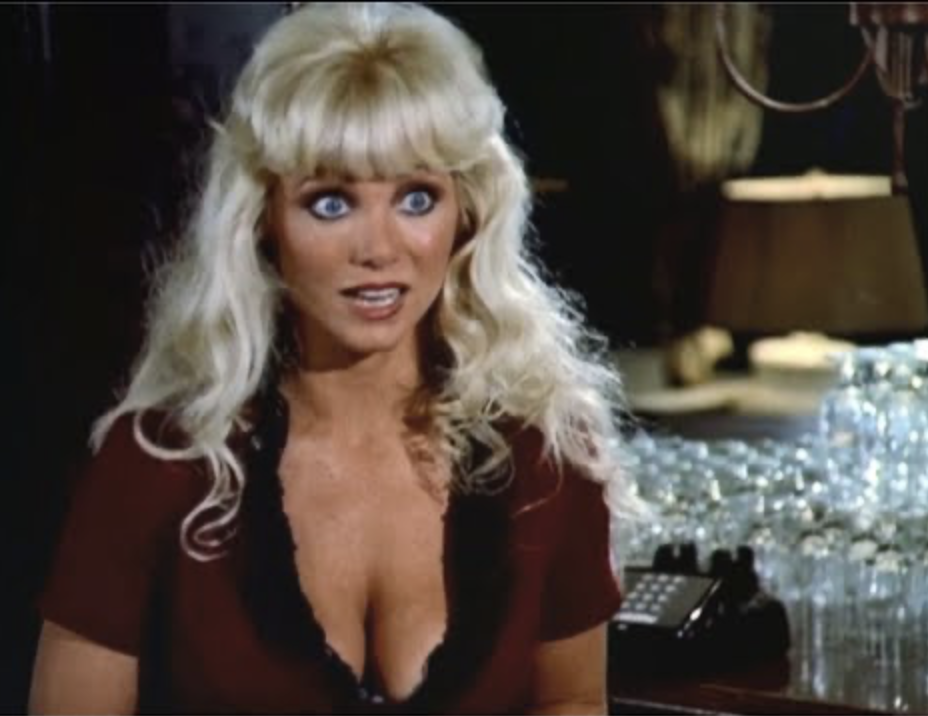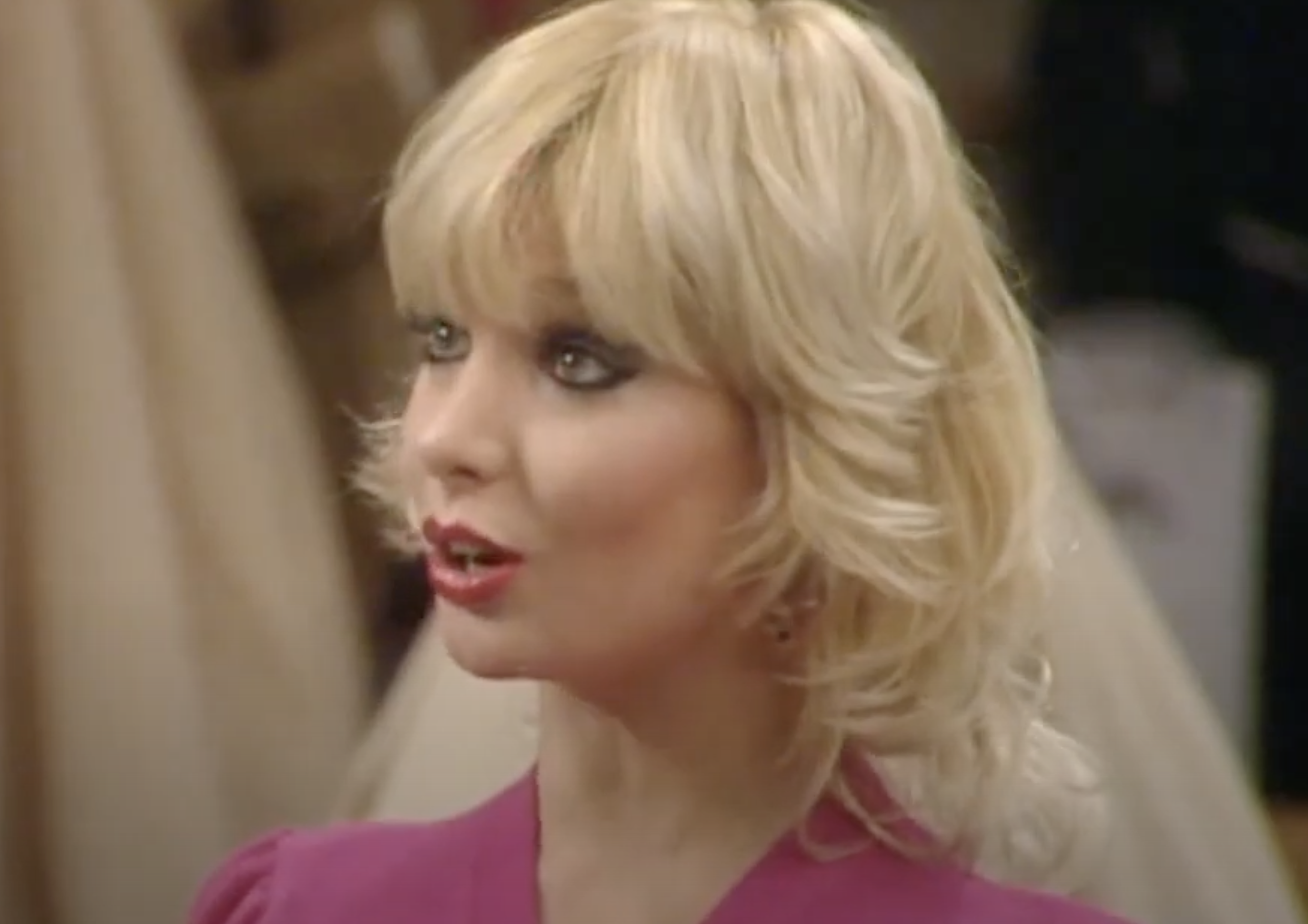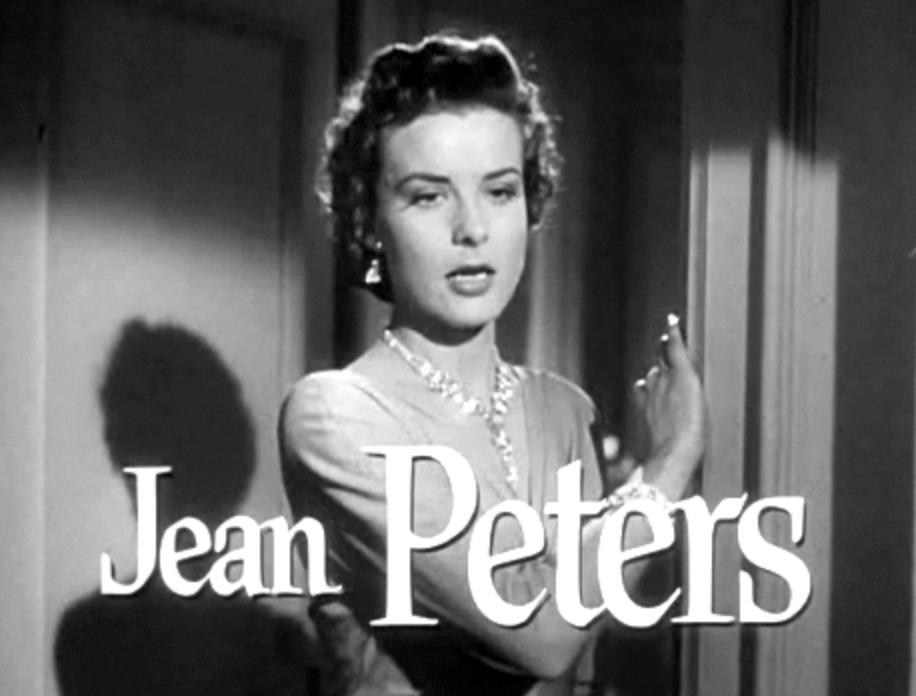Angela Aames (born Lois Marie Tlustos on February 27, 1956) came from humble Midwestern roots before finding her way to the glitz of Hollywood. She grew up in Pierre, South Dakota, a town of around 12,000 people about 200 miles south of Bismarck.
She had developed an interest in acting after watching a play in Pierre called “The Lion in Winter”. But it took some time for her to finally realize that acting was her calling.
“As a young girl,” Aames said. “I thought that was not the thing to do, to become an actress. All I heard about actresses was that they took drugs and committed suicide and lived an awful, ugly life in Hollywood. That’s what I thought.”
In her senior year, she was voted homecoming queen. After graduation, she spent a summer at the Black Hills Playhouse and landed roles in plays there. She then went to the University of South Dakota at Vermillion where she majored in theater arts, acted in plays and was a cheerleader. But after a year of college, she decided to pack her bags and head to California to pursue an acting career.
After a short stint in Sacramento, she made her way to Los Angeles and found work as an apprentice carpenter and an assistant to a private detective. She attended acting class at night at the Lee Strasberg Theater Institute and Harvey Lembeck’s Comedy Workshop.
Adopting the stage name Angela Aames, she soon began to land roles – and her journey from small-town aspiring actress to Hollywood starlet was officially underway.
Right from the start, Aames’s blonde, curvaceous beauty stood out. She possessed the kind of classic bombshell looks – big blue eyes, a bright smile, and an hourglass figure – that Hollywood has long gravitated toward for certain roles. These attributes, paired with an effervescent charm, helped Aames get noticed quickly. However, they also meant she would often be cast in parts that emphasized her physical appeal. As Aames’s career began in the late 1970s, she joined a lineage of actresses typecast as the “buxom blonde,” a familiar archetype in entertainment. Despite the challenges of being pigeonholed, the young actress embraced each opportunity with enthusiasm, determined to make her mark.
Still, she found it rough to adjust to California.
“I spent my first year in Los Angeles learning how to live in an urban society,” Angela said. “I think that was a very difficult thing for me to do because for five or six years of my childhood, I lived on an Indian reservation. Coming to Los Angeles was such a big change. Everything’s so different with all these people. And it’s so impersonal and, often times, unfriendly. If you have a problem (in Pierre), you can stop a person on the street you don’t even know and they’ll help you. Out here, it’s not like that.”
B-Movie Bombshell: Early Roles (1978–1983)
Angela Aames’s film debut immediately set the tone for her career. Her first movie role was as Little Bo Peep in Fairy Tales (1978), a cheeky R-rated musical comedy that put a burlesque spin on nursery rhyme characters. Portraying an adult version of Bo Peep, Aames displayed a playful comedic side and wasn’t shy about the racy, tongue-in-cheek material. The very next year, she was cast in another bawdy comedy, H.O.T.S. (1979), playing a character perfectly in line with her bombshell persona: Linda “Boom-Boom” Bangs. In this college sorority romp, each character had a sexy gimmick – and for Aames’s “Boom-Boom,” it was an infamously over-the-top stunt. In one memorable scene, she performs a topless skydiving jump as part of a sorority prank, literally “dropping in” on a party. The outrageous moment, played for goofy laughs, captured the kind of roles Aames was getting early on: characters that capitalized on her physical attributes and comedic timing in equal measure.
Those first roles firmly established Aames in the late-70s/early-80s sexploitation and raunchy comedy genre. H.O.T.S., for instance, was a low-budget answer to hit college comedies of the era, and Aames fit right in among a cast of young actresses willing to be bold and funny. She later acknowledged that she had essentially been made for the part of “Boom-Boom,” which required confidence and a sense of humor about oneself. While such roles did not make her a mainstream name, they earned Aames recognition in B-movie circles as a rising blonde starlet. She appeared on movie posters, in promotional layouts, and even caught the attention of men’s magazines. Around this time, Aames was featured or mentioned in publications ranging from Playboy and Adam to cult entertainment magazines like Celebrity Sleuth and Femme Fatales, underscoring her growing status as a sex symbol of the B-movie scene.
After Fairy Tales and H.O.T.S., Aames continued to pick up film work, gradually branching into slightly more mainstream projects while still often playing the buxom eye-candy. In 1981, she had a small part in …All the Marbles(also known as The California Dolls), a wrestling comedy-drama starring Peter Falk. Aames’s role as one of the girls in the lead character’s entourage was brief, but it put her in a major studio film and hinted at her ambitions beyond strictly R-rated fare. Then, in 1983, Angela Aames made an appearance in Brian De Palma’s gangster epic Scarface. Though the role – listed as “Woman at Babylon Club #1” – was a minor background part, it placed Aames on screen alongside Al Pacino in one of the decade’s biggest films. For a young actress who had been headlining low-budget romps, even a bit part in Scarface was a noteworthy step. It illustrated how her striking looks could land her a spot even in A-list productions, if only for a moment meant to add glamour to a scene. Those few seconds in Scarface are a testament to how widely Aames was working: from exploitation comedies to high-profile crime dramas, she was finding ways to be seen.
“Certainly a woman would rather play a desirable, sexy lady that an ugly lady, right?” Aames said. ” So my theory is that most women would rather play a sexpot than an ugly girl. I’ve had some women come up to me and say, ‘Oh, I: just think it’s awful that they make you play those parts.’ And my feeling is that they must be jealous because they’re not awful parts. Maybe they would feel exploited playing the part. I don’t.”
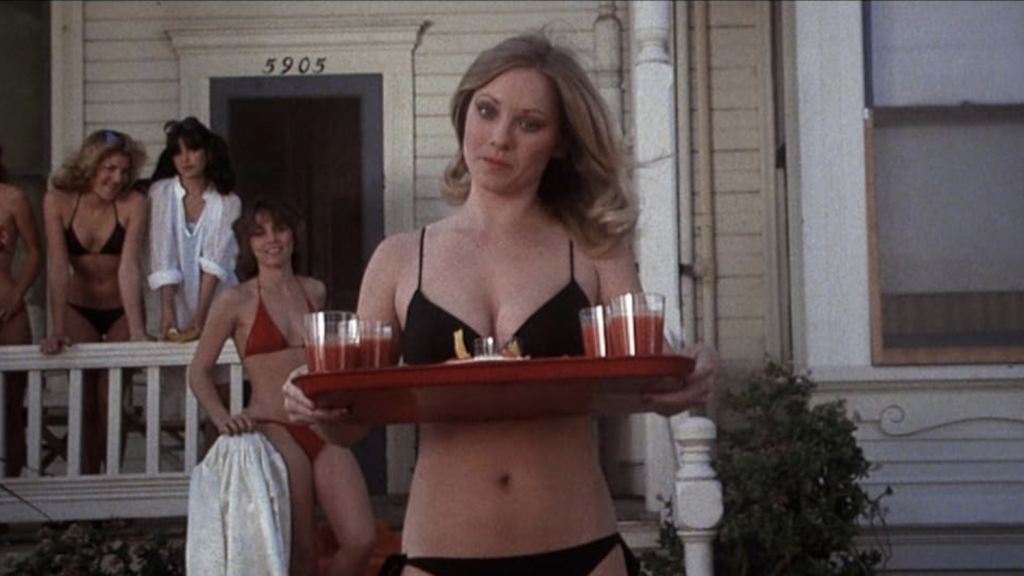
Cult Comedies and Genre Films (1984–1986)
By the mid-1980s, Angela Aames hit her stride with roles that would become her most remembered. In 1984, she appeared in Bachelor Party, the raucous Tom Hanks comedy about one wild night before a wedding. Aames doesn’t have a speaking role in the main plot, but she makes an unforgettable cameo during the film’s opening credits sequence. In that scene, she portrays Mrs. Klupner, a ludicrously well-endowed young mother in a baby photography studio. Surrounded by infants and harried photographers, Aames’s character provides an over-the-top sight gag – her character’s voluptuous figure ends up stealing the spotlight from the crying babies. It’s a brief moment, but audiences noticed the comedic self-parody. That single gag in Bachelor Party encapsulated Aames’s screen persona: she could take a stereotype (the overly sexy mom, in this case) and play it with enough exaggeration and charm to make it funny and memorable. For many ’80s moviegoers, that was their first and lasting impression of Angela Aames.
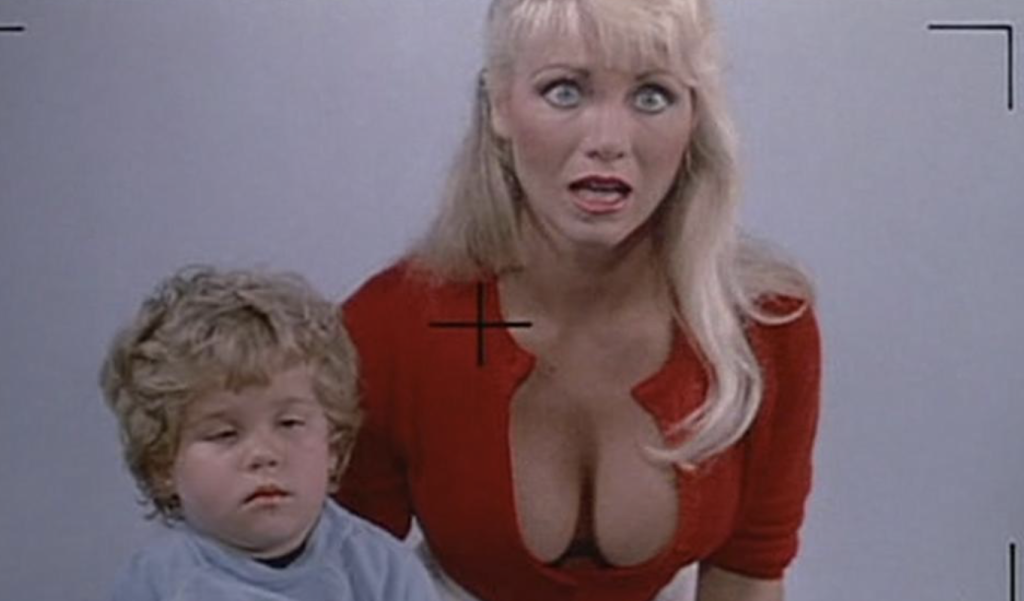
The same year, 1984, also saw Aames take on a more sizable part in the fantasy-adventure The Lost Empire. This film, directed by B-movie impresario Jim Wynorski, is a campy action romp featuring a trio of women who infiltrate an island fortress. Aames co-starred as Heather McClure, one of the three butt-kicking heroines (alongside Melanie Vincz and raven-haired model Raven De La Croix). In The Lost Empire, Aames got to move beyond mere cameos and display some action chops: her character handled weapons, fought henchmen, and still delivered tongue-in-cheek one-liners while clad in skimpy adventure attire. The movie itself was pure pulpy exploitation – complete with magical villains and eye-popping costumes – but it gave Aames a chance to show she could carry more weight in a film. She was still very much the “bombshell” on screen, yet here she was part of the ensemble driving the story. Fans of ’80s B-cinema often cite The Lost Empire as a cult favorite, and Angela Aames’s presence as one of the leads is a big reason why the film has its charm. It demonstrated that Aames could handle action-comedy material and play off her glamorous image while contributing to a film’s momentum.
Angela Aames continued to alternate between comedic roles and genre pieces. In 1985, she took part in Basic Training, a military sex comedy directed by Andrew Sugerman. The film follows a young woman (played by Ann Dusenberry) who finds herself working at the Pentagon, and Aames appears as Cheryl, one of the story’s comedic foils. Basic Training was another low-budget affair heavy on silly, risqué humor – very much in the vein of Police Academy-style or Stripes-style comedy, but more adult-oriented. Aames again played to her strengths, giving the film some of its goofy energy. Though Basic Training is far from a classic (it was critically panned as one of the worst films of 1985), it added to Aames’s string of bawdy comedy credits and kept her working in feature films at a steady clip.
Arguably one of the coolest footnotes in Angela Aames’s filmography came in 1986 with Chopping Mall, a sci-fi horror-comedy produced by Julie Corman. Chopping Mall is remembered as a quintessential ’80s cult film: a gang of teens are trapped in a shopping mall after hours while experimental security robots run amok, turning into killer machines. Aames appears in the film as “Miss Vanders.” Though her time on screen is fairly short, her role is part of the setup – she plays a mall employee (a lab technician or scientist) during a demonstration of the security robots. In her scene, Aames (wearing glasses and a prim outfit, in a bit of “sexy librarian” styling) watches as the robot prototypes are introduced. It’s a small character bit that once again uses Aames’s looks somewhat slyly – she’s the token attractive assistant in a high-tech scenario – and it gives the film a touch of lightness before the mayhem begins. For fans who know Chopping Mall, spotting Angela Aames in that opening adds to the fun of recognizing familiar B-movie actors. And for Aames, Chopping Mall marked one of her last film appearances. It also reunited her with director Jim Wynorski (from The Lost Empire) albeit in a much briefer collaboration this time. Together, these film roles from 1984 to 1986 solidified Angela Aames’s niche in Hollywood: she was the go-to blonde bombshell for comedies, fantasies, and the occasional horror flick, delivering exactly what audiences expected – a wink, a smile, and scene-stealing curves – while always bringing a spirited presence.
Television Roles and Other Media
Parallel to her film career, Angela Aames kept very busy on television throughout the 1980s. In fact, many viewers might recall her face from an array of TV guest spots. Aames had a talent for comedy that translated well to the small screen, and she frequently appeared in sitcoms and light dramas, usually as a one-time character who left a strong impression. Her television debut came as early as 1979 with an episode of the sitcom Angie, and from there she made the rounds on popular shows of the era.
One of Aames’s notable TV appearances was on Cheers in 1982. She guest-starred in the episode “Sam’s Women” (Season 1) as a character named Brandee. In the context of the episode, Brandee is exactly the kind of date you’d expect former-baseball-player Sam Malone to bring to the bar: stunningly attractive but comically dim-witted. At one point, she earnestly comments that Australians “speak a different language,” prompting good-natured eye-rolls. The whole purpose of Aames’s character in that Cheers episode was to satirize Sam’s penchant for shallow relationships and to provoke the envy of Diane (Shelley Long). And Aames played the part to perfection – bubbly, sweet, and oblivious, embodying the “airhead blonde” stereotype that the script called for. Even in a single episode, she managed to stand out. For a show as beloved as Cheers, being remembered for a one-off role is no small feat; Aames’s portrayal of Brandee has been fondly recalled by fans as a quintessential 1980s TV moment highlighting her knack for comedic timing.
Angela Aames also had the distinction of recurring on the action/comedy series B.J. and the Bear. This show, about a trucker and his pet chimp traveling the country, often featured pretty young women in guest roles, especially during a multi-episode storyline about a group of female truckers. Aames appeared in several episodes of B.J. and the Bear around 1979–1981, portraying a character named Honey. With a name like “Honey,” it’s no surprise that Aames was essentially playing a sweetheart who catches characters’ attention. The role let her enjoy a bit more screen time over multiple episodes. Though B.J. and the Bear is largely forgotten today, at the time it had a following, and being a recurring actress on it added to Aames’s TV resume and visibility. It proved she could carry a character across episodes and not just in isolated cameos.
Throughout the early to mid-80s, Aames popped up on a variety of hit shows. Her credits include The Love Boat (where many young actresses got a chance to shine in guest parts), Fantasy Island, Night Court, Alice, The Fall Guy, Hill Street Blues, and even the detective parody Automan. Often these were brief comedic roles – for instance, on Night Court, she appeared multiple times (between 1985 and 1987) as different characters, usually the kind of sexy, quirky woman who would be involved in the courtroom’s nightly shenanigans. The fact that the producers invited her back for several episodes of Night Court (each time as a new persona in the zany world of Judge Harry Stone’s courtroom) suggests that Aames made a positive impression and could be relied upon to get laughs. Whether she was playing a naive fiancee, a sultry bystander, or an eccentric date, she delivered the comedic beat reliably. Similarly, on The Fall Guy, which was a stuntman adventure series, Aames might be seen as a pretty blonde in distress or the object of a light-hearted subplot. In these shows, her appearances were brief but memorable, aligning with how casting directors saw her – as someone who could come in, light up the scene with a bit of humor or glamor, and then exit, leaving audiences smiling.
In addition to traditional network television, Angela Aames ventured into other media formats. A particularly fun credit on her résumé is Likely Stories, Vol. 4 (1983), a comedic anthology that aired on the premium cable channel Cinemax. In that special, Aames had a segment where she portrayed an 80-foot-tall giantess – a literal enlargement of her bombshell persona to fantastical proportions. The piece was essentially a comedy sketch making use of her image in a wildly imaginative way. It’s an example of how Aames was game for almost anything that poked fun at or exaggerated her own stereotype. Likewise, Aames appeared in a handful of TV movies in the early ’80s, such as The Comeback Kid (1980) and This Year’s Blonde (1980). In This Year’s Blonde, which was a biographical TV movie about Marilyn Monroe, Aames fittingly had a bit role as a “Blonde at Pool” – not a far cry from the kind of persona Monroe herself often played early in her career. There’s a bit of poetic symmetry there: Aames, a young blonde actress known for her curves, appearing briefly in a story about the most famous blonde bombshell of all time.
By 1987, Angela Aames finally got a regular role on a series: The Dom DeLuise Show. This was a comedy/variety talk show hybrid featuring the larger-than-life comedian Dom DeLuise. Aames was cast as Penny, a fitness instructor, in the ensemble of the show. Penny was a comedic caricature of the aerobics-craze era – always in workout gear, upbeat and energetic. The role was a bit different from some of Aames’s past parts in that it was part of a core cast (rather than a one-off guest appearance), and it allowed her to develop a recurring comedic character. Unfortunately, The Dom DeLuise Show was short-lived and only ran for one season. Still, Aames’s involvement in it signaled that she was continuing to work steadily and was trusted as a reliable comic actress on television. It also demonstrated how her image translated across formats: whether in films, network sitcoms, or a syndicated variety show, Angela Aames consistently played versions of the bubbly, attractive blonde – sometimes satirizing it, sometimes simply embodying it as a matter of course.
Screen Persona and Public Perception in the 1980s
During her decade-long career, Angela Aames cultivated a distinctive screen persona that was both a blessing and a curse. Professionally, Aames became synonymous with the “blonde bombshell” type in 1980s Hollywood. Casting agents frequently sought her out when a role called for a vivacious, curvy, and somewhat naive young woman to light up the screen. In many ways, she was following in the footsteps of a classic Hollywood archetype – recalling icons like Jayne Mansfield or Mamie Van Doren from earlier eras – but doing so on the smaller stage of B-movies and guest TV roles. The public and her peers often perceived Aames in exactly that light: as a fun-loving sex symbol who didn’t take herself too seriously. She was the actress you’d see in a comedy and instantly recognize as the “sexy girl” character, usually playing it for laughs. This gave her a niche fame; she wasn’t a household name, but to fans of campy movies and TV comedy, she was a familiar face and a welcome presence.
Importantly, Angela Aames approached her image with nuance and good humor. By all accounts, she was self-aware about the roles she was given. On shows like Cheers, for example, she essentially parodied the stereotype of the dumb blonde, leaning into the ditzy behavior for comedic effect. Those who worked with her or wrote about her noted that Aames had a knack for comedy and a willingness to make herself the butt of the joke – a trait that not all “bombshell” actresses possess. This suggests that Aames understood the Hollywood ecosystem she was part of. The 1980s in Los Angeles were a time when physical glamour was heavily emphasized in entertainment; shows and films often featured one-dimensional “pretty girl” characters. Aames managed to imbue those roles with an extra sparkle, which is why she stood out. As one retrospective writer quipped while remembering Aames’s appearance in Bachelor Party, the buxom blonde left an immediate impression on viewers even with minimal screen time. She had that ineffable star quality that could shine through even the smallest part.
However, being typecast also meant Aames faced limitations in her career. In Hollywood, once an actress is identified with a certain image – especially one rooted in sex appeal – it can be challenging to be seen for other types of roles. Aames sometimes spoke about wanting “meatier” parts and indeed made small strides in that direction with films like The Lost Empire, where she wasn’t just decor but part of the story’s driving force. Yet, the industry in the ’80s often didn’t look beyond the surface. The professional perception of Angela Aames largely revolved around her being a delightful on-screen presence rather than a serious dramatic actress. She wasn’t offered the kind of roles that might have showcased a wider acting range – no intense dramas or complex characters came her way in the roles we know of. Instead, she found her opportunities in embracing exactly what she was known for: lighthearted, sexy, comedic entertainment.
In press coverage, Aames was consistently described with adjectives like “buxom,” “blonde,” and “bombshell.” These tags, while flattering, underscored how much her physical appearance defined the narrative of her career. Even in Variety notices or TV Guide listings, mention of her often highlighted her looks. Yet colleagues have indicated that off-camera she was far more than that image. Those who knew or worked with Angela Aames frequently spoke of her professionalism and her warmth. In an era that could be unkind to women who fit a certain mold, Aames earned a reputation for being a genuinely nice person in a business full of ego. In fact, long after her career ended, friends and acquaintances would unanimously recall that she was one of the nicest human beings they had met in Hollywood. This kind-hearted nature endeared her to many within the industry, even if the larger Hollywood machine never really gave her a shot beyond the bombshell roles.
By the late 1980s, Angela Aames seemed poised to continue doing what she did best, and perhaps to explore new facets of her talent. She had kept her career alive for ten years – not an easy task in show business – and had transitioned from exploitative film roles to more mainstream television work. Public perception of her might have simply been as that familiar pretty face on TV or the movies, but professionally Aames was carving out a respectable living. She moved with the times too; as the aerobics craze hit pop culture, she lampooned it as “Penny the fitness instructor” on The Dom DeLuise Show. She was aware of trends and adept at fitting into them in playful ways. In short, Angela Aames knew exactly who she was in the Hollywood ecosystem of the 1980s: a talented comedic actress wrapped in a blonde bombshell package, doing what it took to stay in the game. And she handled that role – both on and off screen – with a mix of humor, grace, and an unpretentious attitude that won her a lot of quiet admiration.
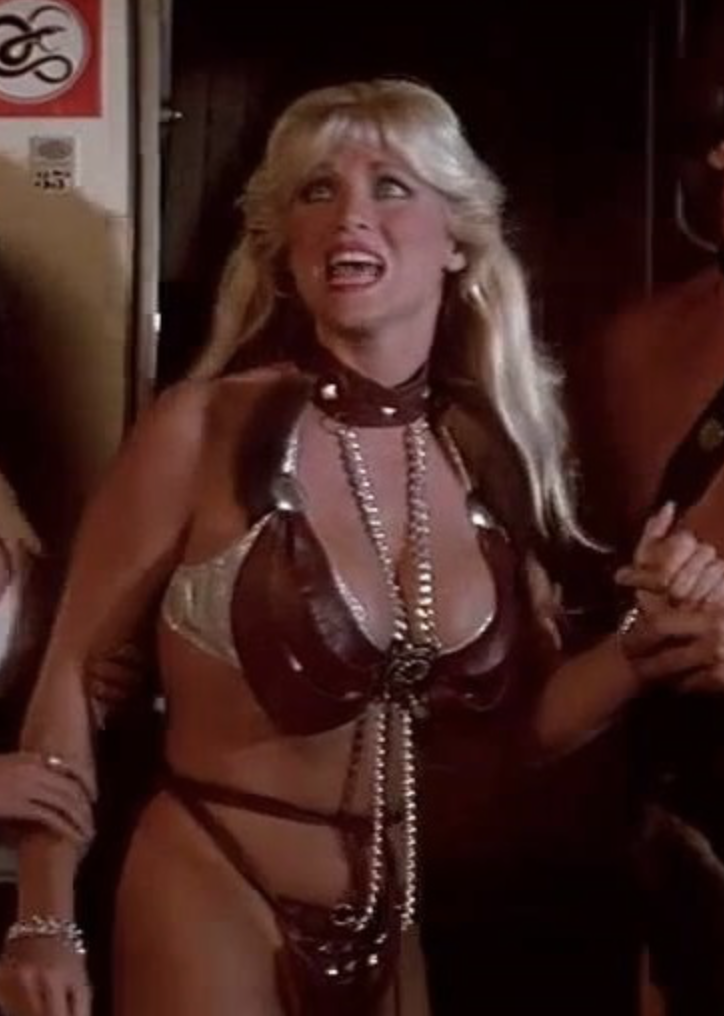
Personal Life Off-Screen
Despite her vivid on-screen persona, Angela Aames led a relatively private life away from the cameras. She was not a fixture of tabloid gossip columns in the way some of her contemporaries were. Aames seemed to keep her personal affairs discreet, focusing on work rather than Hollywood nightlife. However, a few details about her off-screen life help paint a fuller picture of who she was.
In June 1987, Angela Aames married Mark Haughland. This union was a happy milestone for her, coming after nearly a decade of career hustle in Hollywood. Haughland was not a celebrity or public figure, which perhaps suited Aames’s low-key approach to personal matters. Friends would later note that she was genuinely content in her marriage. The couple’s life together was, by most accounts, quite normal – they enjoyed quiet time at home in the Los Angeles area, and Aames balanced her work commitments with her new role as a wife. She even began using her married name in some contexts (one obituary listed “Angela Haugland” as an alternate name), reflecting her embracing this new chapter.
Those who knew Aames personally often remarked on how different she was from the bombshell characters she portrayed. Yes, she had the same warmth and vivacious energy, but she was also down-to-earth and approachable. She hailed from South Dakota and never entirely lost that Midwestern groundedness. Colleagues and friends described her as unfailingly kind, generous with a laugh, and devoid of diva behavior. On set, she was professional and friendly, known to strike up conversations with crew members as easily as with fellow actors. This genuine affability made her a beloved figure to work with, even if she wasn’t a mega-star. It’s telling that in later tributes, people emphasized Angela’s sweetness and good nature above all else.
Aames also had aspirations beyond acting that she rarely publicized. Some reports indicate she had an interest in possibly producing or at least finding roles behind the scenes, perhaps aware that the shelf life for an actress playing “bombshell” parts can be limited. There is evidence she took steps to move beyond pure acting roles – for instance, she was featured in promotional campaigns and even a beer advertisement poster in the late 70s (where she posed in a wet T-shirt for a brewing company’s ad). That suggests she was exploring modeling and commercial work too, expanding her professional repertoire. Additionally, being featured in magazines like Femme Fatales later on indicates she was open to celebrating the kind of cult status she had earned; she engaged with fan press, giving interviews or photo features that capitalized on nostalgia for her roles.
Ultimately, Angela Aames’s personal life seemed joyful yet all too brief. She did not have children (at least none were ever mentioned publicly or in the records surrounding her death), but she had a close-knit family back in South Dakota and siblings she remained connected to. Moving into 1988, Aames was juggling her marriage and career with hopes of more stability – perhaps even starting a family in the near future. Sadly, fate would not allow her that opportunity. What remains clear is that off the screen, Aames stayed true to herself: a kind-hearted soul who valued her loved ones and navigated the tricky terrain of Hollywood with her integrity intact.
Tragic Death in 1988
At the tail end of the 1980s, Angela Aames’s promising life was cut tragically short. On November 27, 1988, she was found dead at a friend’s home in the West Hills area of the San Fernando Valley, Los Angeles. She was only 32 years old. The sudden loss of such a vibrant young actress shocked those who knew her and puzzled the public. Initially, there was considerable mystery around her cause of death. Aames had not been known to have any chronic illness, and she was in the prime of her life, still active and working. Naturally, in Hollywood, such an unexpected passing led to speculation. At first, the Los Angeles County coroner’s office did not release an immediate cause, pending toxicology tests. This gap in information unfortunately opened the door for rumors, and indeed some sensationalist tabloids began whispering that Aames had died of a drug overdose or other scandalous causes.
Friends and family strongly disputed those early rumors. Those close to Angela Aames emphasized that she was not a drug user – in fact, they asserted she had a very clean lifestyle by Hollywood standards. Co-stars and colleagues who spoke in the days after her death described her as health-conscious, and her husband and friends were adamant that whatever happened to her was not due to substance abuse. It was a painful time, made worse by unfounded gossip in certain media outlets. As one friend lamented, hearing false tales in tabloids while grieving was like salt in the wound. The truth, when it emerged, was quite different from the lurid speculation.
In late December 1988, the coroner’s report was finalized and the official cause of death was made public. Angela Aames had died from a condition called idiopathic cardiomyopathy, essentially a sudden deterioration of the heart muscle. In Aames’s case, it was believed to have been brought on by a viral infection – in simpler terms, a virus attacked her heart, leading to acute heart failure. This diagnosis confirmed that her death was due to natural causes, a tragic fluke of health rather than any lifestyle factor. The revelation of a viral heart condition helped silence the overdose rumors. It became clear that Aames was, in effect, a victim of an undetected medical issue – an extremely sad and unforeseen fate for someone so young and seemingly healthy. In hindsight, some who knew her recalled that she had mentioned feeling unwell or extremely fatigued shortly before her death, but nothing that sounded alarm bells at the time. The suddenness of her passing left many in shock.
The impact of Angela Aames’s death was felt among the Hollywood community, especially by those who had worked with her on various sets. While she wasn’t a superstar, she had touched many lives in her decade in the business. Co-stars from shows like Night Court and Cheers expressed condolences. Dom DeLuise, who had worked with her closely in 1987 on his show, reportedly was deeply saddened to lose his young co-star. For many, Aames’s death was a sobering reminder that life is fragile – here was a vivacious woman who just a year earlier had been making people laugh on TV, now gone without warning. The Los Angeles Times ran a brief obituary in early December 1988 noting her work and the mystery around her demise, and a follow-up piece once the cause was known, headlined along the lines of “Actress Aames Died of Heart Problem.” Local news in South Dakota also covered the story, as the hometown girl who found Hollywood success had her life end so abruptly.
Aames’s funeral was a private affair for friends and family. She was survived by her husband Mark Haughland, her mother, two brothers, and three sisters. The family, devastated, received an outpouring of support from both the Pierre community and Angela’s friends in California. In the wake of her passing, those who knew her shared fond memories: her upbeat personality, her willingness to help others, the laughter she brought into every room. Perhaps because Angela Aames was such a positive force, her loss at 32 felt especially cruel. Colleagues reminisced about her infectious laugh and how she could make long days on set a bit easier with her lighthearted jokes. Indeed, the tragedy of her death was not only that she was taken young, but that a genuinely lovely person was lost to the world.
